SUMMARY
This is AI generated summarization, which may have errors. For context, always refer to the full article.
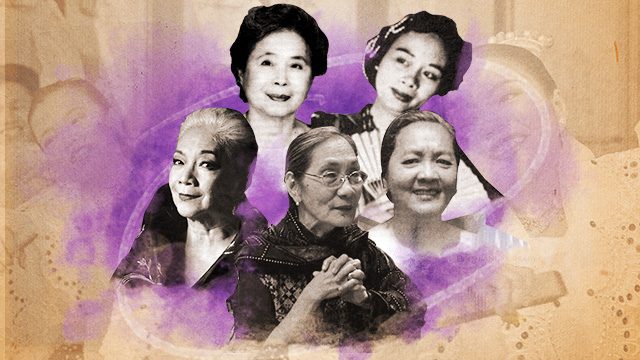
MANILA, Philippines – Filipino dance has always been in spotlight, thanks to various awards and recognitions given to various dance troupes. There are the likes of the Ramon Obusan Dance Troup and the Bayanihan Dance Troupe, both of whom have traveled around the world to promote the country’s various dances.
There are, of course, Filipino groups that have reaped awards from genres like jazz, hip-hop, and ballet – there’s Ballet Philippines, Philippine All Stars, and Jabbawockeez.
But before these groups made it locally and worldwide came 5 women who developed and promoted Filipino folk and modern dance.
Here are the names you should remember:
1. Francisca Reyes-Aquino. Reyes-Aquino is considered the mother of Filipino folk dance. Born in Bocaue, Bulacan, Reyes-Aquino graduated with a BS Education degree from the University of the Philippines. She traveled to various parts of the country to record dances from different provinces. (READ: Google marks Francisca Reyes-Aquino’s 120th birth anniversary with doodle)
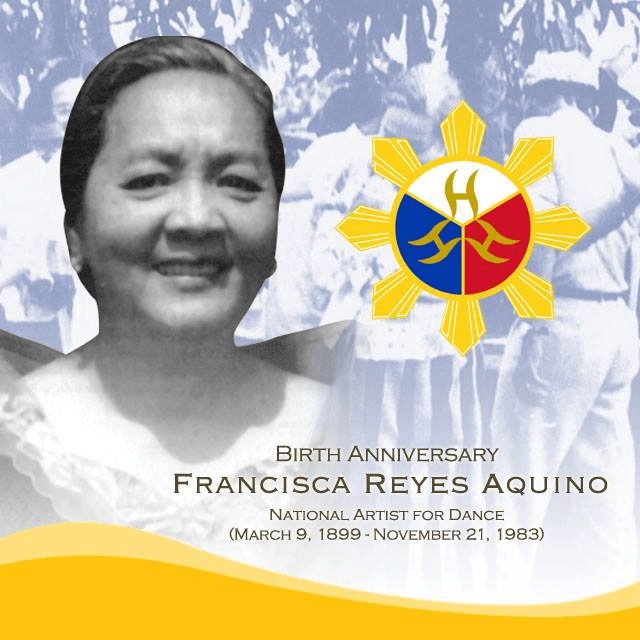
In 1921 during the Manila Fiesta Carnival, Reyes-Aquino, who was a student assistant for Physical Education, presented 4 dances – cariñosa, abaruray, salabat, and areuana. She then earned a master’s degree from UP, where she presented her dissertation Philippine Folk Dances and Games, which would be used by teachers and playground instructors as material for teaching dance.
Reyes-Aquino’s research produced a number of books. She’s the author of Philippine Folk Dances and Games (1927), Philippine National Dances (1946), Gymnastics for Girls (1947), Fundamental Dance Steps and Music (1948), Foreign Folk Dances (1949), Dances for All Occasions (195), Playground Demonstration (1951), Philippine Folk Dances in 6 volumes (1951-1979), Rhythmic Activities (1952), and Philippine Folk Dances and Songs as co-author in 1966.
Reyes-Aquino is also a recipient of a number of awards, including the Ramon Magsaysay Award in 1962. She was named National Artist in 1973 for her contribution to dance.
2. Leonor Orosa-Goquingco. Orosa-Goquingco is known as the “Mother of Philippine Dance Theater” and “Dean of Filipino Performing Arts Critics.” Born in Jolo, Sulu, Orosa-Goquinco finished a BS Education degree, summa cum laude at St. Scholastica’s College. She then took graduate courses in theater craft, drama, and music at Columbia University and Teachers College in New York.
Orosa-Coquinco started as a ballet dancer and also took courses in professional and teacher training under some of the best dance teachers of her time, including National Artist for Dance Francisca Reyes-Aquino.
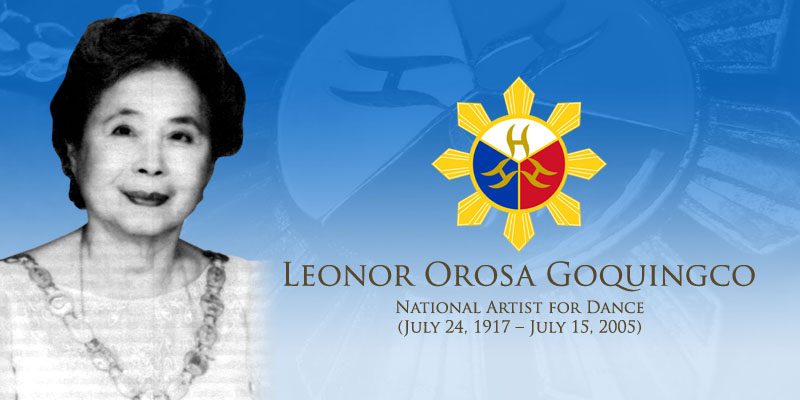
At 17, Orosa-Gonquingco started experimenting with dance. Among the productions she produced include Circling the Globe, Dance Panorama, and The Elements. After World War 2, she organized the Philippine Ballet, where she brought to life Noli Me Tangere onstage. In 1958, she founded the Filipinescas Dance Company, which would go on various tours around the world.
Aside from ballet, Orosa-Gonquingco was known for breaking traditions in dance. Several of her choreographic dances formed the Filipinescas: Philippine Life, Legend, and Lore in Dance production.
Aside from being a dancer, Orosa-Gonquingco also wrote books, essays, and a one-act play. She became the recipient of various awards, including a Presidential Award of Merit in 1970. She was awarded National Artist for Dance in 1976.
3. Lucrecia Reyes-Urtula. Lucrecia Reyes-Urtula started her love for folk dance when she was young. Born in Iloilo, Lucrecia was exposed to many folk dances because of her father, a colonel, who was stationed in various parts of the Philippines.
She took ballet lessons in Baguio and also apprenticed under Francisca Reyes-Aquino. She graduated with a degree in Physical Education from the Philippine Women’s University (PWU) in 1950.
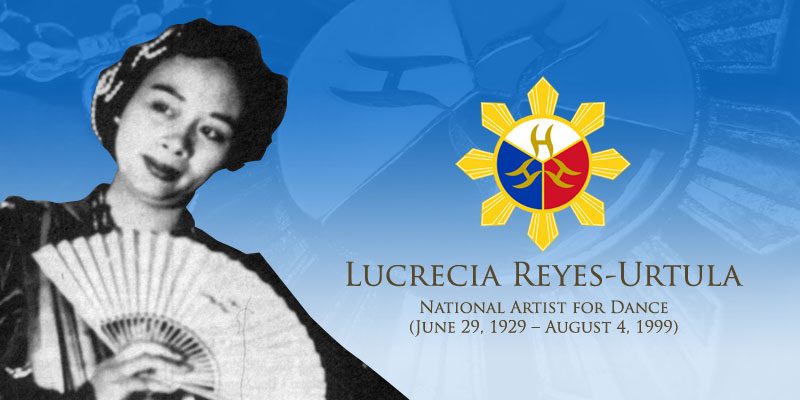
Lucrecia started teaching at PWU and was active in the Filipiniana Folk Arts Group as both teacher and student. In 1955, the group attended the International Festival of Dance and Music in Dacca, Pakistan, which inspired her and the group to continue researching local dances. They also reached out to more indigenous groups to learn about their culture.
She thenbecame part of the Bayanihan Philippine Dance Company. Lucrecia was also its choreographer and dance director. In her tours with the group, Reyes-Urtula started choreographing not just stage but also film and television.
Lucrecia also served as artistic director for dance at the Folk Arts Theater, conceptualized and managed the Philippine Folk Dance Society, among others. She was awarded National Artist for Dance in 1988.
4. Alice Reyes. Alice Reyes comes from a family of performers. Her father Ricardo Reyes was “Mr Folk Dancer” and a pianist, while her mother Adoracion was voice teacher. Her sisters Denisa Reyes and Edna Vida are also dancer-choreographers, while sisters Betty and Cecile are musicians.
After graduating from Maryknoll (now Miriam College) with a degree in History and Foreign Affairs iin 1964, she began to teach in the school and later, took a graduate course at nearby Ateneo de Manila University. She would later on earn various scholarships, including a grant from the John D. Rockefeller III Fund. She later completed her master’s degree in Fine Arts major in dance at Sarah Lawrence College.
Reyes was already exposed to dance at an early age, having danced with her father when she was barely 14. She became a dancer and choreographer for a number of TV shows and productions and performed in various parts of the world.
In 1969, she founded the Alice Reyes and Modern Dance Company, which performed at the Cultural Center of the Philippines. Reyes would later organize dance workshops.
Her group paved the way for the formation of the CCP Dance Company, now known as Ballet Philippines. She would later serve as artistic director of Ballet Philippines from 19970 to 1991.
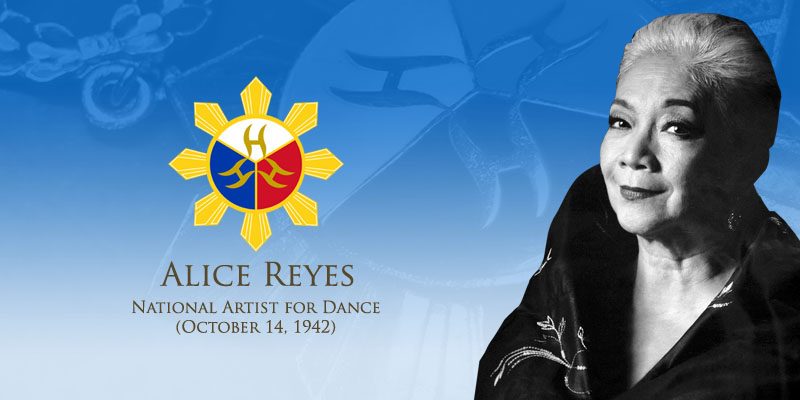
Among her well known dance choreographies include Tales of the Manuvu and Rama Hari, which she worked on with Ryan Cayabyab. Her work with Ballet Philippines has been recognized worldwide, with its use of Filipino and Asian themes and music.
For her work in dance, Reyes, was given a number of awards, including the Gawad CCP para sa Sining and in 2012, was awarded the Gawad Buhay Outstanding Choreopgrahy for Dance for Rama Hari. She was recognized as a National Artist for Dance in 2014.
5. Ligaya Fernando Amilbangsa. Ligaya Amilbangsa is a Ramon Magsaysay awardee, known for her research on the pangalay or igal, a pre-Islamic traditional dance among the ethnic groups in the Southern Philippines.
Amilbangsa first learned of the dance when she her husband, Datu Punjungan Amilbangsa moved to Sulu. Captivated by the pangalay dance, she began to research about it and later studied culture, music, and the visual arts of the Sama and Sama Dilaut (Badjao), Jama Mapun, and the Tausug. Her name became known thanks to the work she did in documenting the pangalay/igal dance style of the Yakan known as pamansak.
Aside from the pangalay, Amilbangsa also documented other dance forms – the langka, a martial dance form and the lunsay, a song-dance tradition.
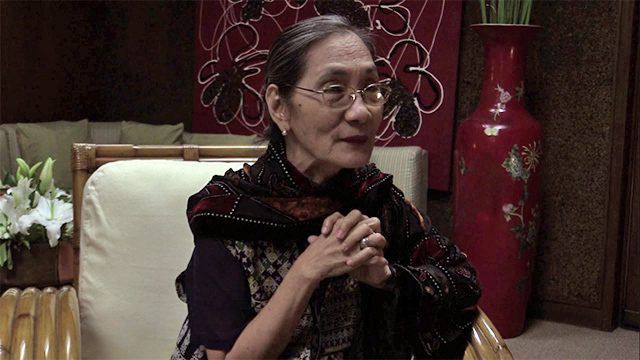
After her researches, Amilbangsa established the Amilbangsa Instruction Method (AIM), which gave children and adults the opportunity to study the pangalay in a scientific and systematic form. She also published two books, Pangalay: Traditional Dancers and Related Folk Artistic Expressions (1983) and Ukkil: Visual Arts of the Sulu Archipelago in 2005.
In Manila, she staged the pangalay and lunsay dances for the Hwa Yi Ethnic Dance Center and co-founded the AlunAlun Dance Circle in 1999, which aims to promote pangalay through performances, research, and dance training.
Her work has been recognized both local and international including UNESCO and the International Dance Competition in Seoul in 1994, where her pangalay choreography won the silver award under the folk dance category.– Rappler.com
Add a comment
How does this make you feel?
There are no comments yet. Add your comment to start the conversation.